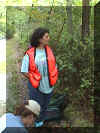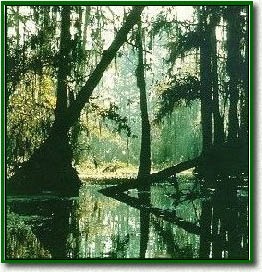





Forest Health Monitoring Vegetation Indicator Pilot
Introduction
Methods
Future
Investigators
Citations
Links
The Forest Health Monitoring (FHM) program is a
national program that makes an annual evaluation of the condition, changes, and trends in
health of forest ecosystems in the United States. The
evaluation of health is based on the sustainable forest management criteria stated in the
Santiago Agreement (Stolte 1997). The
principle ecological criteria in this agreement are productivity, diversity, vitality,
conservation of soil and water, and carbon cycling. This
pilot project is intended to test vegetation indicators (i.e., understory diversity and
general vegetation structure) that will provide data to better evaluate diversity,
vitality, conservation of soil, and carbon cycling in the Nation’s forests. The variables collected in this field pilot also
provide information to evaluate the suitability of forest stands as habitat for wildlife.
The
current FHM methods for evaluating understory plant
diversity were modified for two reasons: the total area sampled was too small (12 m2,
twelve 1 m2 quadrats), and the single-scale approach was inadequate to evaluate
plant diversity in patchy and heterogeneous habitats (i.e., most habitats on Earth)
(Figure 2). Using multi-scale vegetation
plots in forests and rangelands from Colorado to Minnesota, Stohlgren et al. (1995, 1997a,
1998a) found that ten 1 m2 subplots captured only 40% to 50% of the plant
species in a 0.1 ha area. Half the exotic
species in rangelands were missed with a series of 1m2 quadrats (Stohlgren et
al. 1998a). The twelve 1m2
quadrats historically used in the FHM program probably captured even fewer native and
exotic plant species in forested sites due to the patchy distributions of understory
plants in canopy gaps. The single-scale, 1m2 quadrats would gather very
incomplete data on plant diversity and exotic species primarily because most plant species
are locally rare (>50% of the species have <1% foliar cover) and because plants are
never randomly distributed on the plot or landscape (an underlying assumption of
systematic sampling) (Stohlgren et al. 1998a).

 We modified the
USDA Forest Service Forest Health Monitoring (FHM) sampling method to better monitor
native and exotic plant diversity in the Nation’s forests, beginning in Colorado,
Michigan, Oregon, Washington and Virginia. Single-scale
small quadrat techniques were augmented with larger-scale surveys in each plot to record
the number and cover of native and exotic species in two height classes. Data showed that 69% of the forest plots had been
invaded by at least one exotic species. Areas
of high native diversity were most heavily invaded. Exotic
species richness was significantly, positively correlated to native species richness (r+
0.38, P < 0.001) and the cover of exotic species was significantly, positively
correlated to exotic species richness (r = 0.64, P < 0.001). The Vegetation Indicator
Pilot continues into 2001 with the addition of Pennsylvania, Delaware, and Wyoming crews. Some streamlining and fine-tuning was done to the
methods this year based on last year’s results.
We are currently working with Chuck Liff and Brian Cordova who provide
information management support, to design and implement the data apparatus necessary for
quick and efficient data crunching in the future. This
year’s electronic data files will be sent directly from the field to the database for
rapid initial data summary and analysis.
We modified the
USDA Forest Service Forest Health Monitoring (FHM) sampling method to better monitor
native and exotic plant diversity in the Nation’s forests, beginning in Colorado,
Michigan, Oregon, Washington and Virginia. Single-scale
small quadrat techniques were augmented with larger-scale surveys in each plot to record
the number and cover of native and exotic species in two height classes. Data showed that 69% of the forest plots had been
invaded by at least one exotic species. Areas
of high native diversity were most heavily invaded. Exotic
species richness was significantly, positively correlated to native species richness (r+
0.38, P < 0.001) and the cover of exotic species was significantly, positively
correlated to exotic species richness (r = 0.64, P < 0.001). The Vegetation Indicator
Pilot continues into 2001 with the addition of Pennsylvania, Delaware, and Wyoming crews. Some streamlining and fine-tuning was done to the
methods this year based on last year’s results.
We are currently working with Chuck Liff and Brian Cordova who provide
information management support, to design and implement the data apparatus necessary for
quick and efficient data crunching in the future. This
year’s electronic data files will be sent directly from the field to the database for
rapid initial data summary and analysis.
FHM data will allow for detailed analysis of local,
regional, and national patterns of plant diversity. For
Example, analysis of variance of plots in Colorado showed that rangeland habitats had
significantly greater cover of exotic species compared to woodland or timber habitats. The cover of native plants did not differ
significantly on grazed and ungrazed sites in ponderosa pine and pinyon-juniper plots. However, the cover of exotic plants was
significantly greater on ungrazed sites. Early
detection of exotic plant species was significantly enhanced with the new modified FHM
multi-scale vegetation sampling design. Because
hot-spots of native plant diversity are being heavily invaded by exotic plant species,
managers of National Forests and rangelands face a formidable challenge. This national network of plant diversity
monitoring is an important first step in assessing the extent of exotic species invasion
at large spatial scales. The Pilot is
scheduled to go national in the year 2001.
Dr. Dan Binkley
Affiliation: Colorado
State University
A116
Natural & Environmental Sciences Building
Colorado
State University
Fort
Collins, CO 80523
Co
Investigator: Dr.
Thomas J. Stohlgren
Affiliation: Midcontinent
Ecological Science Center
Biological
Resources Division
United
States Geological Survey
Address: Natural
Resource Ecology Laboratory
Colorado
State University
Fort
Collins, CO 80523-1499
USDA Forest Service Contact:
Ken Stolte
Affiliation: Southern Research Station
Address: Forestry Sciences
Laboratory
3041
Cornwallis Road
P.O.
Box 12254
Research
Triangle Park, NC 27709
Local Forest Service Contact:
Merrill Kaufmann
240
West Prospect St.
Fort
Collins, CO 80526-2098
Stohlgren,
T. J., M. B. Falkner, and L. D. Schell. 1995. A modified-Whittaker nested vegetation
sampling method. Vegetatio 117:113-121.
Stohlgren,
T. J., G. W. Chong, M. A. Kalkhan, and L. D. Schell. 1997a. Rapid assessment of plant
diversity patterns: A methodology for landscapes. Ecological Monitoring and Assessment (In
Press).
Stohlgren,
T.J., G.W. Chong, M.A. Kalkhan, and L.D. Schell. 1997b. Multiscale sampling of plant
diversity: effects of minimum mapping unit
size. Ecological Applications 7:1064-1074.
Stohlgren,
T. J., M. B. Coughenour, G. W. Chong, D. Binkley, M. Kalkhan, L. D. Schell, D. Buckley,
and J. Berry. 1997c. Landscape analysis of plant diversity.
Landscape Ecology 12: 155-170.
Stohlgren,
T.J., D. Binkley, G.W. Chong, M.A. Kalkhan,
L.D. Schell, K.A. Bull, Y. Otsuki, G. Newman, M. Bashkin, and Y. Son. 1998a. Invasion of hot spots of native plant diversity by
exotic plant species. Ecology (In press).
Stohlgren, T.J., K.A. Bull and, Y. Otsuki. 1998b. Comparison of rangeland sampling techniques in the central grasslands. Journal of Range Management 51:164-172 March 1998.
Contact the Multi-scale Team Webmaster with any questions:
last updated 14 September 2000